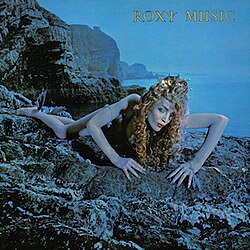In 2009, during the first of what have become periodic reunions, I saw My Bloody Valentine play the Fillmore Auditorium in Denver. On stage, MBV personify the musical genre whose name they helped inspire, shoegaze. They seemed lost in a world that only existed between their guitars and pedalboards. They didn’t say so much as “boo” to the audience.
But they did play all their “hits,” all of Loveless, most of Isn’t Anything, even a couple earlier songs I didn’t recognize, all played at teeth-rattling volume. At the time, the Fillmore was a big, uncomfortable theater with a huge parquet floor, like five gymnasiums laid side by side, and absolutely atrocious sound dampening. MBV played loud enough to punish. Rest in peace, anyone who didn’t have earplugs.
It was a solid, professional show, but I wouldn’t have considered it anything more than that…until the final song, “You Made Me Realize.” It started as you would expect with its hard, fuzzy, dissonant hits: one, two, three, and four. So far, so good. A nice high energy rocking finale. And then, three quarters of the way through the band just…got stuck. They kept playing one chord over and over again, like a CD skipping.
I would later learn that extending “You Made Me Realize” was a hallmark of the MBV live show, and that they would often stretch the 3:47 track with up to twenty minutes of grinding, shrieking noise. Fans dubbed it the “holocaust” section.
But this wasn’t quite that. It wasn’t quite an atonal cacophony. It was literally one chord, followed by a drum fill, followed again by that very same chord. Bwrammmm, a tom fill: dum, da, da, dum, dum. Dozens and dozens…and then hundreds of times.
After five minutes, I grew bored. My feet hurt. My ears hurt. The crowd shuffled anxiously. Some people left. I looked over at a crowd mate like: can you believe this shit?
At about minute ten, the agitation left my body. This was all just a big joke, made even funnier by the band’s straight-faced stoicism. I laughed out loud. It got swallowed by the 120 decibel squall.
At about minute fifteen, it wasn’t funny anymore. It was entrancing, tribal…relaxing. The crowd had stopped moving: their arms limp, their mouths agape. No one talked. No one laughed. No one thought about how their car was parked or what time they had to go to work tomorrow or how much they needed to go to the bathroom. We just thought about that next chord – bwrammmm! – so loud you feel it in your chest. And then we got a reprieve as the chord decayed and the drums completed their fill. Then: bwrammmm!
When the band finally brought the song to a close, the audience was spent. There was no encore. We shuffled out in a daze.
***
“This is the three ‘r’s / the three ‘r’s,” Mark E. Smith sings on The Fall’s, “Repetition.” What are the three ‘r’s? “Repetition, repetition, repetition.”
Beat follows beat. Note follows note. Breath follows breath. Stroke follows stroke. Ha follows ha. Honestly, 90% of music is doing the exact same thing that you just did, and the biggest reason that choruses are important is because they get repeated.
But some types of music take this to the extreme. In the late ‘60s James Brown stripped music down to one chord that his band, the JBs, would pick at for five, ten, 20 minutes. A little over a decade later, Detroit DJs would chop up his beats (and others’), run them through samplers, and speed them up, birthing techno – and electronic dance music as we understand it today. This was repetition machined efficiency.
As the 1980s turned into the 1990s, British kids on ecstasy merged dance music with the psychedelia-inspired guitar rock of the indie underground. Records like The Stone Roses’ self-titled debut and Primal Scream Screamadelica laid the groundwork for bands like Oasis, Blur and Pulp to dominate guitar rock in the 1990s.
But today’s album presages them both, even though the formula is the same: guitars, spaciness, an altered state, and, of course, repetition, repetition, repetition.
Released in 1987, Spacemen 3’s Perfect Prescription is somewhat forgotten nowadays, probably overshadowed by bands that would that would make up the Madchester scene and by Britpop as a whole, and certainly by Spacemen 3 co-founder Jason Pierce, whose band Spiritualized is still going strong today, and whose 1997 album Ladies and Gentlemen We Are Floating in Space is considered one of the best albums of the 1990s, and, perhaps, the pinnacle of a genre the Spacemen helped revitalize, space rock.
Like their fellow guitar-slingers in the UK in the mid-80s, Spacemen 3 looked backwards to take their music forward. Pierce and Peter Kember (who goes by Sonic Boom) fashioned their band in the mold of The Stooges and The Velvet Underground with a crucial double helping of Suicide, the confrontational NYC drum machine and keyboard duo who used to assault 1970s audiences with songs like the ten-minute horror fiction of “Frankie Teardrop,” about a factory worker who kills his wife, their infant, and then himself.
Nothing in Spacemen 3’s songbook is that controversial, though the largely encouraging British press tut-tutted the band members’ vocal and varied drug use. Drugs, after all, were a founding precept of the band, so much so that their demos would be released with the title Taking Drugs to Make Music to Take Drugs To.
Perfect Prescription is undoubtedly drug music: narcotic tempos, a pair of guitars that are pumped with enough distortion to sound like waves crashing or enough tremolo to cause jitters, droning organ, and repetitive lyrics chanted as if they were zen koans. This is vibe music, and the vibes are at least partially fucked.
Spacemen 3 adhere to Lou Reed’s rules on drums and chords: 1.) “cymbals eat guitars,” and 2.) “One chord is fine. Two chords are pushing it. Three chords and you’re into jazz.” Spacemen 3 never quite get into jazz (on bonus tracks, they do cover MC5’s version “Starship” from jazz’s most galactic mystic Sun Ra), but on the album’s centerpiece, “Transparent Radiation,” they do include some hints of orchestration.
Perfect Prescription takes the shape of a drug trip. The opener “Take Me to the Other Side” is thrashing rock, the speedy burst of a hit hitting. The acoustic strums and droning organ of “Walkin’ with Jesus” is a mellower plateau that continues into the Reed tribute “Ode to ‘Street Hassle.” At the peak of the trip, “Transparent Radiation” is blissful and shimmering, floating on picked guitars, strings, and droning horns – all of it very subtle, rising and falling like waves of euphoria. “Feel so good today,” a voice intones dozens of times on “Feel So Good,” suggesting that maybe the singer actually isn’t doing so hot anymore.
A burst of reversed delay indicates that the drugs have turned on “Things’ll Never Be the Same.” Strummed electric guitar returns and kicks up the noise. The country shuffle “Come Down Easy” and the nocturnal “Call the Doctor” close out the album. And then it’s time for bed.
After four albums – the last of which was basically two solo EPs stuck together – Pierce and Kember would fall out, with differing creative visions, truly wretched management, and Kember’s inability to deal with Pierce’s girlfriend all being contributing factors. I’m sure the drugs didn’t help either.
Nowadays you can hear Spacemen 3’s influence in bands who amble instead of rock, bands who sing without raising their voices, and bands who love tremolo pedals. I hear them most prominently in the seven-minute, two chord jams of Kurt Vile and The War on Drugs – fellow space cowboys who certainly side with drugs in that particular war.







